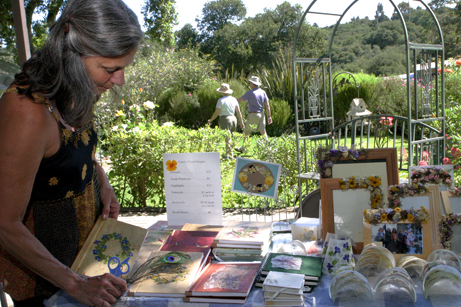
Tour highlights artwork, gardens and more
Story and photos by DANIELLE STOLMAN
Special to The Pinnacle
Mary Medina of Gilroy attended the 14th annual Aromas County
Garden Tour looking for inspiration.
Her current yard needs a lot of work.
”
Right now it’s nothing, just dirt,
”
she said.
Tour highlights artwork, gardens and more
Story and photos by DANIELLE STOLMAN
Special to The Pinnacle
Mary Medina of Gilroy attended the 14th annual Aromas County Garden Tour looking for inspiration.
Her current yard needs a lot of work. “Right now it’s nothing, just dirt,” she said.
Medina found some ideas in the “laid back, English style” of the first garden. She would eventually like her own garden to be “nice and welcoming with beautiful flowers and greenery.”
Pat Emard of Rio del Mar described her current garden as overgrown with many plants needing to be pulled.
Emard, who has taken the garden tours of many towns, also brought her friend and neighbor, Anne Marie Sazenelli, so she could get ideas.
Sazenelli’s gardens are “just serviceable” and in particular she wants to work on the yard in front of her house, she said.
The tour began as a one-time neighborhood fund-raiser for The Friends of Anzar Hills, Robin Brown, a tour co-founder and owner of one of the gardens on the tour, said.
The tour attracts both local people and visitors from towns including Monterey, Santa Cruz, San Jose, and San Francisco, Linda Bjornson, the president of Aromas Hills Artisans and chairman of the Garden Tour Committee, said. She greeted people at the Grange, the first stop on last weekend’s tour where maps could be purchased.
“It’s astounding to see that it has kept going, getting bigger and with so many people involved,” tour co-founder Sally Diggory said.
This year’s tour featured gardens at seven homes and two businesses. The gardens on the tour were marked on the road with colorful windsocks.
Janet Wenholz brought her friend Bernie Epolite, both of Gilroy, to celebrate her birthday in a unique way. Wenholz bought a Purpled-leaved Jacob’s Ladder for her garden.
The plant’s leaves look and feel similar to those of ferns. It is known to attract butterflies, according to the tag provided on the plant.
Wenholz liked that the money for the plant benefited the 4-H Club, she said.
Epolite enjoyed the tour with her friend, she said. “What a birthday,” Epolite said.
Gilberto Segovia had his garden on the tour for the second year in a row.
A strong floral scent emanated from his garden. Some of his plants are easy to grow and some are hard, he said. His garden featured several Orchid Cacti which have smooth, waxy leaves and are characterized by different colored flowers.
Sheila Dominguez has been cultivating her garden for almost four years. This was her first year on her tour. “People enjoying gardens and all of my creative efforts is reinforcement that what I’m doing is a good thing”, she said.
Her garden, which is about two-thirds of an acre, contains over 100 species of Plants. Most are primarily Mediterranean drought-tolerant plants.
Several birds chirped and sang throughout the garden.
Both her brother, who is the manager of water conservation for the Contra Costa Water District, and her sister-in-law, who has a nursery in Carmel, were on hand to help with the tour and answer questions on plants and water conservation. “It’s a real family thing; we’re all into plants and gardening,” she said.
Dominguez also provided free lemonade to people taking the tour. It featured Meyer lemons from her garden that she had picked and squeezed four months ago.
“I wanted the lemonade to be neither to sweet nor too tart, so people will want a second glass,” she said.
Additionally the gardens at 799 Seely and 861 Rebecca Circle featured artists in the garden with eight artists selling their wares at each.
“The artists were separated into the two gardens with a variety of media in each, a painter, a ceramic artist, a weaver, and so on,” Bjornson said. “One of distinguishing features of our group is the variety of media our artists have,” she said.
Bjornson is a both professional stained glass artist and a gardener. In past years her garden has been a stop on the tour. “I told them this year they could have me as chairman or they could have the garden,” she said with a laugh.
Several artists were also demonstrating the processes to make their art to the public. Carol Hughes, a floral artist who also works with other media, was decorating pairs of flip-flops with “pieces of yarn left over from scarves,” she said.
“I was raised in the era of ‘Don’t throw it away. Save it, reuse it,’ ” Hughes said. Her recycling efforts include using dried flowers to decorate picture frames and cards. A friend gave her the recently shed skins of her snakes telling her, “I’m sure you will find some use for them”. The skins were placed on journals and nightshades. The skins feel different from those people find in nature, Hughes said. “It is surprising how soft and supple the skins (of snakes kept inside) are”, she said.
Hughes had taken the tour about five times before, and was approached by Diggory to exhibit her artwork. In addition to exhibiting her work, she found advertisers for the map booklet, Hughes said.
Diggory also demonstrated making her ceramic pieces. She put two pinch pot pieces together to form one large piece. She especially likes making pieces in the form of animals, particularly bears and rhinoceroses.
Deidra Kmetovic is a bead artist who designs beads using soft efretti glass heated in a propylene torch. The rods used must be heated to 2,000 degrees so they will expand properly and not crack. Kmetovic welcomed questions from her audience adding that “the torch is loud, you’ll probably have to shout them to me.”
Annie MacHale is a weaver who uses an inkle loom to create pieces including guitar straps such as the one she made on the tour. This was her first year being in the tour as an artist. “The colors I weave today (teal and purple) are the ones I’m wearing today. It’s sort of a common thing for me,” she said.
“The sales of the maps benefit the Aromas Artisans in the form of scholarships for professional development, as well as providing programs and scholarships to high school students and as supplementary art supply money to three local grade schools which have had funding cuts” Bjornson said.









